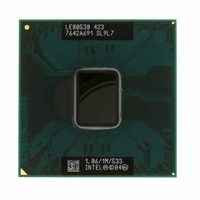LE80538VE0041M Intel, LE80538VE0041M Datasheet - Page 12

LE80538VE0041M
Manufacturer Part Number
LE80538VE0041M
Description
IC PROC CELERON M 1.06GHZ 479BGA
Manufacturer
Intel
Datasheet
1.LE80535NC013512.pdf
(69 pages)
Specifications of LE80538VE0041M
Processor Type
Celeron M
Features
533MHZ Bus, 1M L2 Cache
Speed
1.06GHz
Voltage
0.94V
Mounting Type
Surface Mount
Package / Case
479-BGA
Lead Free Status / RoHS Status
Lead free / RoHS Compliant
Other names
883549
Available stocks
Company
Part Number
Manufacturer
Quantity
Price
Low Power Features
2.1.3
2.1.4
2.1.5
12
The system can generate a STPCLK# while the processor is in the AutoHALT Power-Down state.
When the system deasserts the STPCLK# interrupt, the processor will return execution to the
HALT state.
While in AutoHALT Power-Down state, the processor will process bus snoops.
Stop-Grant State
When the STPCLK# pin is asserted, the Stop-Grant state of the processor is entered 20 bus clocks
after the response phase of the processor issued Stop-Grant Acknowledge special bus cycle.
Since the AGTL+ signal pins receive power from the FSB, these pins should not be driven
(allowing the level to return to V
state. In addition, all other input pins on the FSB should be driven to the inactive state.
RESET# will cause the processor to immediately initialize itself, but the processor will stay in
Stop-Grant state. A transition back to the Normal state will occur with the deassertion of the
STPCLK# signal. When re-entering the Stop-Grant state from the Sleep state, STPCLK# should be
deasserted ten or more bus clocks after the deassertion of SLP#.
A transition to the HALT/Grant Snoop state will occur when the processor detects a snoop on the
FSB (see
assertion of the SLP# signal.
While in the Stop-Grant State, SMI#, INIT# and LINT[1:0] will be latched by the processor, and
only serviced when the processor returns to the Normal State. Only one occurrence of each event
will be recognized upon return to the Normal state. Please refer to the FERR# pin description in
Section 4.2
While in Stop-Grant state, the processor will process snoops on the FSB and it will latch interrupts
delivered on the FSB.
The PBE# signal can be driven when the processor is in Stop-Grant state. PBE# will be asserted if
there is any pending interrupt latched within the processor. Pending interrupts that are blocked by
the EFLAGS.IF bit being clear will still cause assertion of PBE#. Assertion of PBE# indicates to
system logic that it should return the processor to the Normal state.
HALT/Grant Snoop State
The processor will respond to snoop or interrupt transactions on the FSB while in Stop-Grant state
or in AutoHALT Power-Down state. During a snoop or interrupt transaction, the processor enters
the HALT/Grant Snoop state. The processor will stay in this state until the snoop on the FSB has
been serviced (whether by the processor or another agent on the FSB) or the interrupt has been
latched. After the snoop is serviced or the interrupt is latched, the processor will return to the Stop-
Grant state or AutoHALT Power-Down state, as appropriate.
Sleep State
The Sleep state is a low-power state in which the processor maintains its context, maintains the
phase-locked loop (PLL), and has stopped all internal clocks. The Sleep state can only be entered
from Stop-Grant state. Once in the Stop-Grant state, the processor will enter the Sleep state upon
Section
for details on FERR# break event behavior in the Stop Grant state.
2.1.4). A transition to the Sleep state (see
CCP
) for minimum power drawn by the termination resistors in this
Intel
Section
®
Celeron
2.1.5) will occur with the
®
M Processor Datasheet












